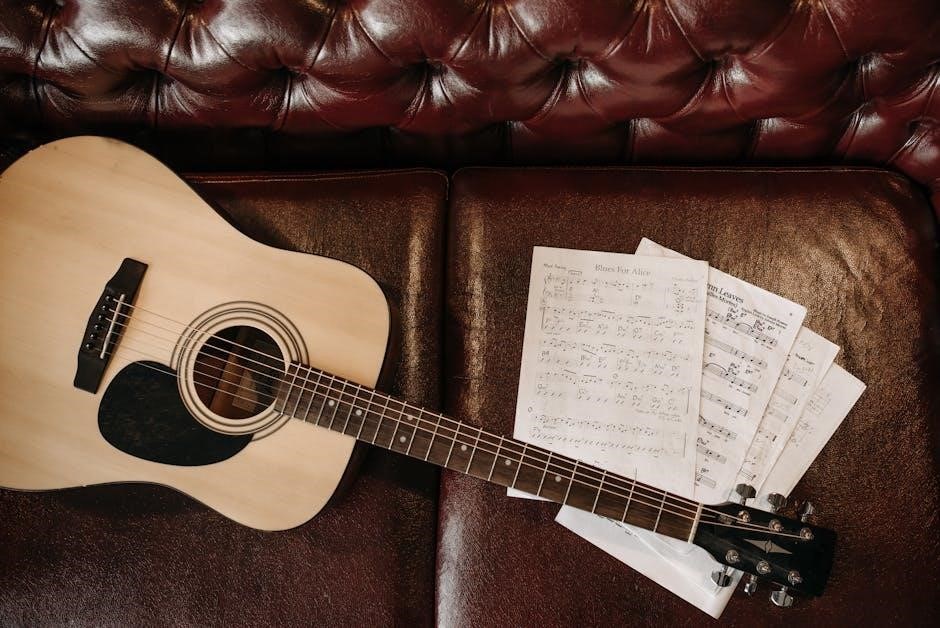The Moonlight Sonata‚ composed by Ludwig van Beethoven‚ is a timeless masterpiece in C-sharp minor‚ widely recognized for its haunting beauty and technical complexity. Its first movement‚ Adagio sostenuto‚ is particularly celebrated‚ with sheet music available in PDF formats for free download‚ making it accessible to pianists worldwide.

1.1. Overview of the Moonlight Sonata
The Moonlight Sonata‚ officially known as Piano Sonata No. 14 in C-sharp minor‚ Op. 27‚ No. 2‚ is one of Ludwig van Beethoven’s most celebrated compositions. Its dreamy‚ introspective first movement‚ marked Adagio sostenuto‚ has captivated audiences worldwide. The piece is often associated with its nickname‚ “Moonlight‚” due to its evocative and shimmering quality. Composed in 1801‚ it was dedicated to his pupil‚ Countess Julie “Giulietta” Guicciardi. The sonata’s sheet music‚ particularly the first movement‚ is widely available in PDF and MIDI formats‚ allowing pianists of all levels to explore its haunting beauty and technical challenges. Its enduring popularity lies in its emotional depth and the way it bridges classical and romantic musical styles.
1.2. Historical Background and Composition
Composed in 1801‚ the Moonlight Sonata was part of Beethoven’s early romantic period‚ showcasing his innovative approach to music. It was dedicated to Countess Julie Guicciardi‚ a pupil and potential romantic interest. The sonata’s unique structure and emotional depth marked a departure from classical norms. The first movement‚ Adagio sostenuto‚ is notable for its delicate‚ flowing arpeggios and dreamy character. Beethoven’s hearing loss began around this time‚ yet he continued to compose masterpieces. The piece was officially published in 1802‚ with the famous nickname “Moonlight” coined later by critic Ludwig Rellstab‚ inspired by its resemblance to moonlight on Lake Lucerne. Its enduring appeal has made it a cornerstone of piano repertoire‚ with sheet music widely available in PDF and MIDI formats for modern pianists to interpret and perform.
1.3. Popularity and Cultural Significance
The Moonlight Sonata has become one of the most recognizable and beloved pieces in classical music‚ transcending its original context to resonate with global audiences. Its first movement‚ with its dreamy‚ introspective quality‚ has been widely used in films‚ commercials‚ and popular culture‚ further cementing its iconic status. The piece is often associated with romance and emotional depth‚ making it a favorite for pianists and music lovers alike. Its enduring popularity has led to numerous adaptations and arrangements‚ ensuring its relevance across generations. Additionally‚ the availability of free PDF and MIDI downloads has made it accessible to aspiring pianists‚ fostering a continued appreciation for Beethoven’s masterpiece.

Structure of the Moonlight Sonata
The Moonlight Sonata is a three-movement piano sonata‚ showcasing Beethoven’s innovative composition. The first movement‚ Adagio sostenuto‚ is known for its lyrical‚ introspective melody. The second movement‚ Allegretto‚ offers a contrasting‚ lively rhythm‚ while the third movement‚ Presto agitato‚ is a dramatic‚ virtuosic finale. This structure highlights Beethoven’s mastery of dynamic range and emotional depth‚ making the sonata a cornerstone of classical music.

2.1. First Movement: Adagio Sostenuto
The first movement of the Moonlight Sonata‚ titled Adagio sostenuto‚ is a serene and introspective piece in C-sharp minor. It begins with a dreamy‚ arpeggiated chord progression that creates a hypnotic effect. The melody flows gently‚ supported by a steady‚ broken chord accompaniment in the left hand. This movement is characterized by its lyrical simplicity and emotional depth‚ with dynamics primarily remaining pianissimo. The tempo is moderate‚ allowing for expressive phrasing. Beethoven’s innovative use of pedaling instructions enhances the movement’s ethereal quality. The Adagio sostenuto is widely regarded as one of the most recognizable and beloved piano pieces‚ showcasing Beethoven’s mastery of expressive composition.
2.2. Second Movement: Allegretto
The second movement of the Moonlight Sonata‚ marked Allegretto‚ presents a stark contrast to the first movement’s introspective nature. Composed in D-flat major‚ it offers a brighter‚ more vibrant tone‚ with a lively yet graceful tempo. This movement showcases Beethoven’s mastery of rhythmic precision and contrapuntal interplay‚ featuring a scherzo-like character with a central trio section. The dynamics are more pronounced‚ shifting from delicate passages to moments of dramatic intensity. While the first movement is often celebrated‚ the Allegretto provides a refreshing contrast‚ emphasizing Beethoven’s versatility and innovative approach to sonata structure. Its technical demands and musical depth make it a compelling part of the sonata‚ rounding out the work’s emotional and structural complexity.
2.3. Third Movement: Presto Agitato
The third movement of the Moonlight Sonata‚ marked Presto Agitato‚ is a virtuosic finale that contrasts sharply with the preceding movements. Composed in C-sharp minor‚ it unfolds at a breakneck tempo‚ showcasing Beethoven’s innovative use of rhythm and dramatic flair. The movement is characterized by relentless arpeggios‚ rapid passagework‚ and a sense of urgency‚ creating a thrilling conclusion to the sonata. Its technical demands are immense‚ requiring exceptional dexterity and stamina from the performer. Despite its challenges‚ the Presto Agitato remains a testament to Beethoven’s genius‚ offering a dramatic and emotionally charged climax that leaves a lasting impression on listeners.
The First Movement: Adagio Sostenuto
The Adagio Sostenuto‚ in C-sharp minor‚ is the opening movement of Beethoven’s Moonlight Sonata. It is known for its dreamy‚ introspective quality and technical demands‚ requiring precise pedaling and dynamic control to achieve its hauntingly beautiful sound.
3.1. Musical Characteristics and Style
The first movement of the Moonlight Sonata is characterized by its introspective and dreamy quality‚ with a flowing arpeggiated triplet figuration in the right hand. Composed in C-sharp minor‚ it features a somber‚ melancholic tone‚ enhanced by Beethoven’s innovative use of dynamics and pedaling techniques. The movement is marked Adagio sostenuto‚ indicating a slow‚ sustained tempo that demands precise control. The left-hand accompaniment provides a steady‚ pulsing rhythm‚ while the right hand delivers a lyrical‚ singing melody. This structure creates a sense of tension and resolution‚ culminating in a dramatic buildup toward the end. The piece’s technical demands‚ including delicate fingerwork and nuanced dynamics‚ make it a hallmark of Romantic piano repertoire.
3.2. Key Signature and Tonality
The first movement of the Moonlight Sonata is written in the key of C-sharp minor‚ a key with seven sharps‚ adding to its dramatic and somber character. The music revolves around a central tonality‚ with Beethoven employing modulation to create a sense of tension and resolution. The use of minor keys emphasizes the introspective and melancholic nature of the piece. Beethoven’s innovative approach to tonality‚ particularly in the way he explores related keys‚ contributes to the movement’s emotional depth. The key signature and tonal structure are crucial elements that define the sonata’s unique sound and expressiveness‚ making it one of the most recognizable and beloved pieces in classical music repertoire.
3.3. Tempo and Dynamics
The first movement of the Moonlight Sonata is marked Adagio sostenuto‚ indicating a slow and sustained tempo that creates a calm yet intensely emotional atmosphere. Beethoven’s use of dynamics is masterful‚ with the music beginning softly (pianissimo) and gradually building through subtle crescendos and diminuendos. The dynamic contrasts enhance the piece’s dramatic character‚ while the sustained arpeggios in the left hand provide a shimmering backdrop for the haunting melody. Performers are encouraged to observe Beethoven’s phrasing and dynamic markings closely to preserve the work’s expressive intent. The interplay between tempo and dynamics is central to conveying the movement’s profound emotional depth and technical brilliance.

Sheet Music Availability
The Moonlight Sonata first movement’s sheet music is widely available online in PDF and MIDI formats‚ with free downloads on platforms like PianoCoda.com‚ Free-scores.com‚ and mfiles.co.uk.

4.1. Free PDF Downloads
Free PDF downloads of the Moonlight Sonata first movement are readily available on platforms like PianoCoda.com and Free-scores.com. These high-quality scores are accessible to everyone‚ offering a convenient way to obtain and print the sheet music. Many websites provide the piece in its original form‚ ensuring authenticity and fidelity to Beethoven’s composition. The PDFs often include detailed dynamics‚ articulation‚ and tempo markings‚ making them suitable for both professional pianists and beginners. Some versions are even arranged by talented musicians‚ offering fresh interpretations while maintaining the essence of the original work. This accessibility has made the Moonlight Sonata a beloved piece for pianists worldwide.
4.2. Paid Sheet Music Options
For those seeking high-quality‚ professionally edited sheet music‚ paid options are available on platforms like Musicnotes.com and SheetMusicPlus.com. These sites offer meticulously transcribed versions of the Moonlight Sonata first movement‚ ensuring accuracy and clarity. Paid versions often include additional features such as audio recordings‚ MIDI files‚ and interactive tools for practice. Purchasing from reputable publishers guarantees authenticity and supports the creators of these resources. While free downloads are convenient‚ paid sheet music provides enhanced quality and reliability‚ making it a worthwhile investment for serious musicians and educators seeking precise interpretations of Beethoven’s masterpiece.
4.3. MIDI Files and Digital Versions
MIDI files and digital versions of the Moonlight Sonata first movement are widely available‚ offering versatile tools for musicians. These files provide a customizable experience‚ allowing pianists to adjust tempo‚ practice specific sections‚ and analyze the piece’s structure. Digital versions often come with interactive features‚ such as metronome settings and looping capabilities‚ enhancing practice sessions. Websites like PianoCoda.com and Free-scores.com offer MIDI downloads‚ enabling users to explore the composition’s nuances digitally. These resources are particularly useful for educators and students‚ facilitating deeper engagement with Beethoven’s masterpiece while maintaining the integrity of the original composition. They serve as a modern complement to traditional sheet music‚ making the Moonlight Sonata accessible in new and innovative ways.
Features of the Sheet Music
The Moonlight Sonata sheet music features a piano solo arrangement‚ offering a clean layout with clear notation. It includes dynamics‚ pedal markings‚ and expressive instructions‚ ensuring authenticity and playability for pianists of all levels.
5.1. Piano Solo Arrangement
The Moonlight Sonata 1st movement is primarily arranged for piano solo‚ maintaining Beethoven’s original composition for a single instrument. This arrangement highlights the piece’s intricate melodies and harmonies‚ designed to be performed without accompaniment. The sheet music features a clean layout‚ ensuring readability and ease of performance. It includes detailed dynamics‚ articulation‚ and pedal markings‚ which are essential for capturing the piece’s emotional depth. The arrangement remains faithful to Beethoven’s intent‚ offering pianists a challenging yet rewarding experience. Its solo nature allows for a direct connection between the performer and the music‚ making it a popular choice for both professionals and aspiring pianists.
5.2. Instrumental Range and Difficulty
The Moonlight Sonata 1st movement is written for solo piano‚ requiring a moderate to advanced level of technical proficiency. The piece spans a wide instrumental range‚ with intricate arpeggios and octave stretches that demand good hand dexterity and finger independence. The music features dynamic contrasts‚ from delicate pianissimo passages to more dramatic fortissimo sections‚ which test a pianist’s control and expression. While the movement is not as technically demanding as the third movement‚ its legato playing and nuanced pedaling requirements make it challenging. The sheet music includes detailed markings to guide performers in mastering these aspects‚ ensuring a faithful interpretation of Beethoven’s expressive composition.
5.3. Page Layout and Formatting
The Moonlight Sonata 1st movement sheet music PDF is typically presented in a clean‚ professional layout‚ ensuring readability for pianists. Most versions span 5 pages‚ with clear note placement and legible fonts. The formatting includes dynamic markings‚ tempo indications‚ and pedal instructions‚ essential for accurate performance. Many free and paid versions feature standardized musical notation‚ with measures evenly spaced to avoid clutter. Some arrangements include fingerings or performance notes‚ aiding interpretation. The PDFs are often compatible with both screen and print‚ making them versatile for practice and performance. Sources like PianoCoda.com and Free-scores.com offer neatly formatted versions‚ preserving Beethoven’s original intent while enhancing accessibility for modern musicians. This ensures a seamless experience for pianists of all levels.

Performance Techniques
Mastering the Moonlight Sonata requires precise pedaling‚ nuanced dynamics‚ and expressive articulation. Pianists must maintain a delicate touch‚ adhering to Beethoven’s pianissimo markings and fluid tempo transitions for a captivating performance.
6.1. Pedaling Instructions
Proper pedaling is essential for capturing the ethereal quality of the Moonlight Sonata’s first movement. The sustain pedal should be used sparingly to maintain clarity‚ while the sostenuto pedal helps sustain specific melodies. The una corda pedal softens the sound‚ enhancing the piece’s delicate passages. Beethoven’s notation indicates “pianissimo” throughout‚ requiring careful balance between resonance and control. Pianists should avoid overusing the sustain pedal to prevent muddiness‚ especially in arpeggiated sections. Modern pianos may require adjustments‚ as Beethoven’s instrument differed. By mastering these techniques‚ performers can achieve the desired dreamy‚ flowing effect that defines the Moonlight Sonata. Pedaling instructions in sheet music guides often provide detailed markings for optimal interpretation. Always consult historical scores for precise guidance.
6.2. Dynamics and Articulation
The first movement of the Moonlight Sonata demands precise control of dynamics and articulation. Markings such as pianissimo and delicatissimamente indicate a soft‚ delicate touch throughout. The melody flows in a legato style‚ requiring smooth connections between notes. Beethoven’s notation specifies minimal use of fortissimo‚ emphasizing instead subtle dynamic shifts. Articulation is mainly espressivo‚ with careful attention to phrasing. Players must balance the sustained chords with the moving arpeggiated figures‚ ensuring clarity and avoiding muddiness. The sheet music often includes detailed markings to guide these nuances‚ helping pianists achieve the desired ethereal quality. Proper dynamic control and articulation are key to conveying the emotional depth of the piece. This section requires meticulous practice to master its expressive demands.
6.3. Interpretation and Expression
The first movement of the Moonlight Sonata is renowned for its emotional depth‚ requiring pianists to convey a sense of introspection and poetic expression. Beethoven’s notation specifies playing delicatissimamente and senza sordini‚ emphasizing a delicate‚ undamped sound. The sheet music guides interpreters with markings like pianissimo and espressivo‚ encouraging a subtle‚ expressive performance. Players must balance technical precision with artistic sensitivity‚ capturing the movement’s dreamy‚ almost improvisatory quality. The use of rubato and nuanced dynamics enhances the emotional impact‚ while adhering to Beethoven’s phrasing and articulation marks ensures authenticity. Proper interpretation requires a deep connection to the music’s Romantic essence‚ making it a rewarding yet challenging piece for pianists. The sheet music’s detailed instructions help performers achieve this expressive brilliance.

Learning the First Movement
Free PDF and MIDI downloads simplify accessing the first movement’s sheet music‚ offering pianists of all levels a convenient way to learn and perform this iconic piece effectively.
7.1. Practice Tips for Beginners
Beginners should start by downloading the Moonlight Sonata sheet music in PDF format to access clear notation and dynamics. Breaking the piece into smaller sections allows focused practice on challenging arpeggios and chord progressions. Using MIDI files to listen to the movement can provide a reference for tempo and phrasing. Practicing hands separately helps build finger independence and control. Starting at a slower tempo ensures accuracy before increasing speed. Emphasizing pedal markings‚ such as the sustain pedal‚ enhances the dreamy quality of the music. Regular practice‚ even in short sessions‚ fosters progress and familiarity with Beethoven’s intricate composition.
7.2. Advanced Performance Insights
Advanced pianists should focus on nuanced dynamics and phrasing to convey the emotional depth of the Moonlight Sonata. Emphasizing the sustained‚ singing melody in the right hand while maintaining soft‚ flowing arpeggios in the left hand is crucial. Paying close attention to Beethoven’s pedal markings ensures the desired legato and atmospheric sound. Exploring subtle tempo variations can enhance the expressive quality‚ particularly in the quasi fantasia style. Advanced players may also experiment with rubato to add personal interpretation. Studying recordings by renowned pianists and analyzing their approaches can provide inspiration and refine technique. Mastering the balance between technical precision and emotional expression is key to a compelling performance of this iconic movement.

7.3. Common Challenges and Solutions
Mastering the Moonlight Sonata’s first movement presents several challenges‚ particularly in maintaining the delicate balance between the melody and accompaniment. A common issue is achieving the required softness (pianissimo) without losing clarity‚ which can be addressed by focusing on finger independence and controlled pedaling. Another challenge is managing the sustained arpeggiated chords in the left hand‚ which may require slow‚ repetitive practice to build stamina and dexterity. Additionally‚ maintaining a steady tempo while interpreting the expressive phrasing can be tricky. Listening to professional recordings and working with a metronome can help. Regular practice and patience are essential to overcome these challenges and deliver a polished performance of this beloved piece.

Additional Resources
Find Moonlight Sonata sheet music in PDF and MIDI formats on platforms like PianoCoda.com and Free-scores.com. Explore tutorials‚ recordings‚ and analyses for deeper understanding and practice.
8.1. Audio Recordings for Reference
Audio recordings of the Moonlight Sonata are essential for reference‚ offering insights into tempo‚ dynamics‚ and expression. Platforms like PianoCoda.com and Free-scores.com provide high-quality recordings alongside sheet music downloads. These recordings‚ often performed by renowned pianists‚ serve as invaluable tools for both beginners and advanced musicians. They allow listeners to appreciate the nuanced interpretations of the piece‚ aiding in understanding the composer’s intent. Dynamics and articulation are particularly evident in these recordings‚ helping pianists refine their technique. Additionally‚ such resources enable comparisons of various performances‚ fostering a deeper appreciation for the sonata’s complexity and beauty.
8.2. Video Tutorials and Lessons
Video tutorials and lessons provide visual guidance for mastering the Moonlight Sonata’s first movement. Platforms like YouTube and specialized music websites offer step-by-step instructions‚ breaking down complex passages. Many tutorials feature experienced pianists demonstrating proper technique‚ dynamics‚ and expression. These resources are particularly beneficial for beginners‚ as they illustrate finger placement and pedaling techniques. Advanced players can also gain insights into interpretative nuances. Some videos include side-by-side displays of sheet music‚ syncing visuals with audio for better comprehension. Channels such as Serge K and educational platforms like PianoCoda.com offer high-quality lessons‚ making the sonata more accessible to learners of all levels. These visual aids complement sheet music‚ enhancing practice effectiveness.
8.3. Further Reading and Analysis
For deeper understanding‚ enthusiasts can explore books‚ articles‚ and online resources analyzing the Moonlight Sonata. Websites like PianoCoda.com and Free-scores.com offer detailed analyses of the composition‚ including historical context and musical structure. Academic articles delve into Beethoven’s creative process and the sonata’s cultural impact. Additionally‚ music theory blogs provide insights into the piece’s harmonic innovations and technical challenges. These resources are invaluable for musicians and scholars seeking to enrich their interpretation and performance of the sonata’s first movement. They complement sheet music downloads by offering a broader perspective on Beethoven’s masterpiece.
The Moonlight Sonata’s first movement remains a cornerstone of piano repertoire‚ with its sheet music widely available in PDF for both free and paid access‚ ensuring its enduring legacy.
9.1. Summary of Key Points
The Moonlight Sonata‚ composed by Ludwig van Beethoven‚ is one of the most iconic piano pieces in classical music. Its first movement‚ Adagio sostenuto‚ is particularly renowned for its dreamy‚ introspective quality. Sheet music for this piece is widely available in PDF format‚ with both free and paid options accessible online. Websites like PianoCoda.com and Free-scores.com offer high-quality downloads‚ catering to pianists of all skill levels. The first movement is structured in a quasi-fantasia style‚ making it a favorite among both performers and audiences. Its enduring popularity ensures that the Moonlight Sonata remains a cornerstone of musical repertoire‚ with its sheet music continuing to inspire and educate pianists worldwide.
9.2. Final Thoughts on the Moonlight Sonata
The Moonlight Sonata stands as a testament to Beethoven’s genius‚ with its first movement captivating audiences for centuries. Its availability in PDF format ensures accessibility for pianists‚ fostering a deeper connection to the music. The piece’s emotional depth and technical challenges make it a rewarding experience for performers. As a cultural icon‚ it continues to inspire new interpretations and adaptations‚ keeping its legacy alive. Whether played by professionals or enthusiasts‚ the Moonlight Sonata remains a timeless treasure in classical music‚ offering endless opportunities for artistic expression and appreciation.
9.3. Encouragement for Musicians
Musicians‚ whether beginners or advanced‚ are encouraged to explore the Moonlight Sonata through its readily available sheet music in PDF format. Embrace the opportunity to connect with Beethoven’s timeless masterpiece‚ which offers a profound emotional and technical journey. The first movement’s haunting beauty and intricate nuances provide a rewarding challenge for pianists. With free and accessible resources‚ musicians can delve into practice and interpretation‚ fostering growth and artistry. Remember‚ the Moonlight Sonata is not just a piece of music—it’s a gateway to expressing deep emotion and mastery. Let its legacy inspire you to push boundaries and refine your craft‚ ensuring its beauty continues to resonate through your performances.





